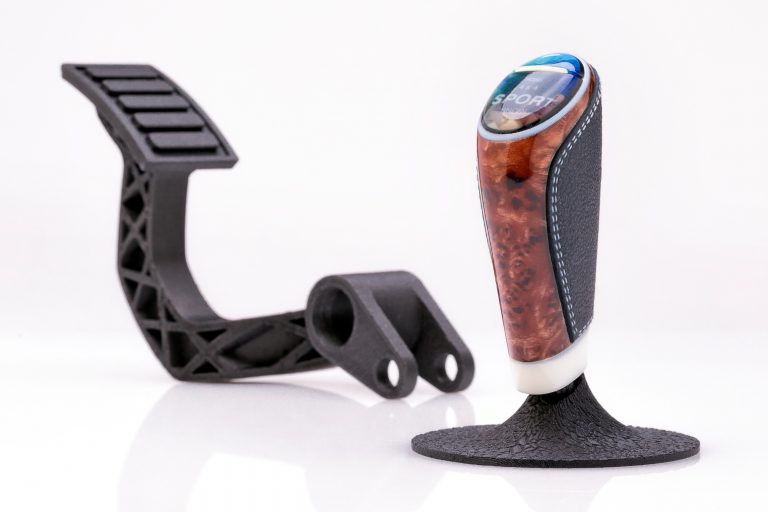Additive Manufacturing Complements Injection Molding
Additive Manufacturing (AM) has garnered attention due to the certification and validation of AM processes and materials as a strong and viable option for conventional manufacturing. This recognition is propelling AM from one-off prototype form-fit-function use, to end-use production components in demanding applications and industries, with volumes in the millions per year.
Xcentric is in the business of providing time critical manufacturing services that address the different phases of our customers’ product launch cycles. Historically our focus has been on injection molded thermoplastic components; however, as our customers’ requirements change and manufacturing technologies advance, XME has evolved to offer the desired outcome using the best available approach. Because we have expertise in both injection molding and additive manufacturing we are able to propose the best approach for each phase of our customers’ projects.

We offer the following Additive Manufacturing technologies
- Fused Deposition Modeling
- Stereo-lithography
- Selective Laser Sintering
- Selective Laser Melting
- DLP Printing
- PolyJet
- Multi Jet Fusion
3D Printing in the Product Development Cycle
Additive manufacturing—or 3D Printing—is a great solution when a component is needed immediately, in low volumes, and when the part design is highly complex and would be difficult to manufacture using conventional methods. 3D Printing also enables designers and engineers to iterate quickly, modify designs, and go to market quickly, without the need for costly inventory because parts can be printed on-demand. Additive manufacturing technologies include a wide range of directly printed polymers and metals and an even broader range of materials via intermediate processes such as thermoforming and sand casting. In recent years, increasing numbers of 3D printing companies—including our partner Stratasys Direct—are validating materials for end-use applications, and industrial-grade 3D printing services have risen that are able to produce small production parts in higher volumes.
<h2>Get your first concept model with Xcentric 3D prototyping service</h2>
Today, additive manufacturing sees pervasive adoption by engineers turned innovators. Xcentric is proud to be one of them to broaden our services for 3D-printed and molded parts at any product development stage (Xcentric is now part of the Quickparts family which has extensive 3D capabilities). As a result, you can rely on us to get your concept model 3D-printed in the material you need, with the geometries you thought were hard to achieve, and in a way that opens the floodgates to customization.
Xcentric and Quickparts’ industrial 3D printing services have you covered for quickly turning 3D design concepts into tangible items. This will work best for photopolymer, nylon, powdered metal, thermoplastics, and other materials.
It takes less time to get your prototype 3D-printed in low volumes than injection-molded. 3D printing is also a more efficient option, reducing the need to stock up on and store materials while trying to foresee material waste produced with molding and traditional manufacturing techniques. Because it is a layer-by-layer process, 3D printing generates minimal waste with selective laser sintering and other efficiency-centric AM technologies.
3D prototyping service delivered in one go
Are you in the middle of verifying your parts’ design intricacies and manufacturability? 3D printing is your best bet for any product development stage that does not involve agreed-upon design decisions and voluminous production runs. As part of 3D printing, Xcentric delivers a single-step prototyping service, which is:
- Easy to set up without sourcing additional equipment and tooling
- Adjusted for the unique properties and shapes of your components
- Executed for your custom assembly and finishing needs
- Delivered when you need it – often within as few as five days
- Agile enough to leave wiggle room for modifications on the fly
Our industrial 3D printing services can help you move forward from the ideation, validation, and prototyping stages with unprecedented efficiency and flexibility. Using 3D-printed components, you can quickly see how they perform in an assembly, whether they fit, and what design changes are necessary before starting full-scale production with injection molding.
Which AM process is right for you?
Xcentric moves with the times to help you reap the benefits of the latest AM techniques. We operate SLA, SLS, SLM, FDM, PolyJet, and other printers to amplify them for your components. When it makes more sense to have your product 3D-printed than injection-molded, let us know which AM process suits your project based on:
- Material (nylon, thermoplastics, filament coils, etc.)
- Design intricacies such as irregular surfaces, curves, and net styles
- How many items
- Desired finish
- Manufacturability and specific industrial standards
- Your budget
Nothing is more reassuring than discussing your additive manufacturing options with the Xcentric and Quickparts team. We draw on over 25 years of experience in the AM and injection molding sector to create your concept model and move on with large-scale production. Let’s talk today!
Additional Resources
The icons below will help you easily navigate to additional resources for Injection Molding